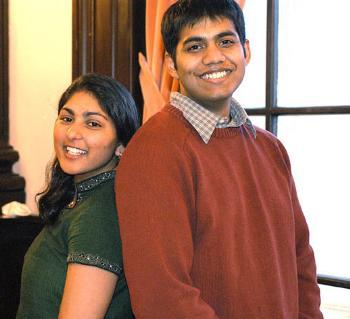
News
Summers Will Not Finish Semester of Teaching as Harvard Investigates Epstein Ties

News
Harvard College Students Report Favoring Divestment from Israel in HUA Survey

News
‘He Should Resign’: Harvard Undergrads Take Hard Line Against Summers Over Epstein Scandal

News
Harvard To Launch New Investigation Into Epstein’s Ties to Summers, Other University Affiliates

News
Harvard Students To Vote on Divestment From Israel in Inaugural HUA Election Survey
Spotlight
Charitha Gowda ’04 and Deip Nandi ’04

Geordie Broadwater will spend his fall semester working in Harvards premier theater venue, directing the Harvard debut of Temptation on the Loeb Mainstage. An English concentrator, this leading figure of the Harvard theater community has both acted and directed in numerous plays at Harvard. He is also a member of the Immediate Gratification Players. Above, he is pictured performing in Performancee Artists for Responsible Art (PART), an ad hoc group which staged visible anti-war actions around campus.
Describe your current project.
Im directing on the mainstageits a play called Temptation by Vaclav Havel, who was formerly president of the Czech Republic. Its a really exciting project. I feel that its the first play that matches me tonally, because its funny and serious at the same time.
How is Harvard as a community for artists?
Its kind of great and kind of terrible at the same time. I think its great because theres a lot of opportunity and its an extremely intellectual environment. On the other side of the coin, its a very traditional environment also, so theres a lot to be asked for as far as the level of innovation.
Which do you prefer: acting or directing?
In the Harvard community, I like directing better. Its sort of an ideal world because you have so many great resources and so much freedom. I dont know what Id like better in the real world, because I love acting.
How would you describe yourself in three words?
Enthusiastic, sloppy and pretentious.
What do you think of the Common Casting process? Any suggestions on making it better?
Well, we submit our cast lists, and then were at the mercy of the actors, as to whether they take the roles or not. I dont think thats the process where we will make the best shows as a community, but that is the best process for the actors. I couldnt think of any other way to do it.
Where do you imagine yourself in ten years?
Im from New York, so eventually I want to go back to New York. Theres probably a big difference between what I imagine myself doing and what Ill actually end up doing, but Id like to be an actor or a director or something in the world of theater. Either that, or Ill move to Australia.
What would you like to relive from your four years at Harvard?
I wish I had seen more plays and shows in generaldance or art shows. The more people I meet, the more I realize I havent seen anything theyve done, and thats very sad.
What has been your most fulfilling artistic/academic experience?
I had this one semester where I was taking an English class on American and British theater, a directing class, a playwriting class and a core. That was a great semester. Its always been nice to balance a practical class like playwriting or directing with classes where you approach the same topic from an entirely intellectual perspective.
What would you consider to be your biggest quirk?
I need to spend at least three hours a day by myself.
Who are your ultimate heroes?
My ultimate heroes are Einstein, because hes really smart, and Artaud, because hes nuts. But in a good way.
What is the most inspiring locale on campus?
Every once and a while, I will steal a moment to hang out in either the [Loeb Experimental Theater] or the Mainstage by myself, optimally when theres no set. Thats really awesome.
Want to keep up with breaking news? Subscribe to our email newsletter.
